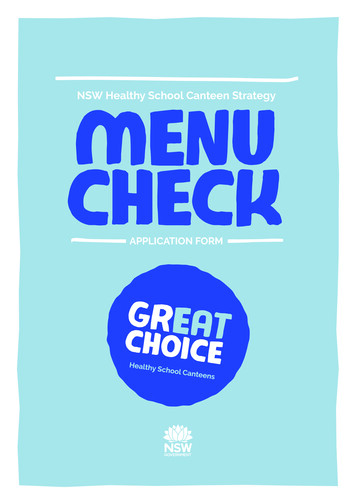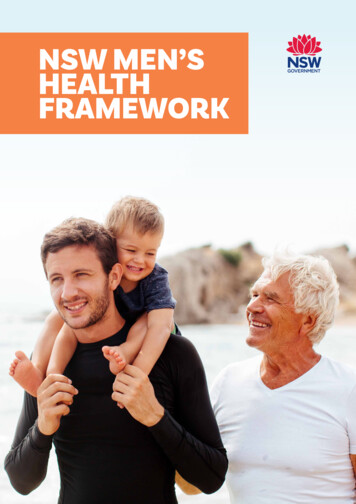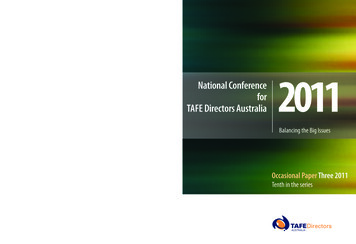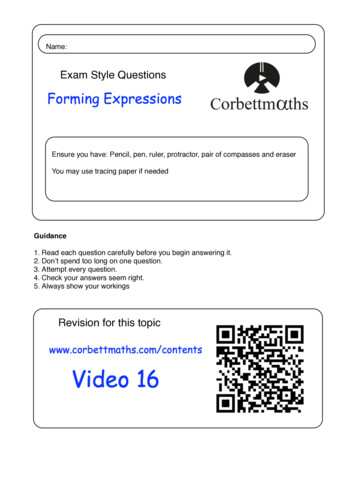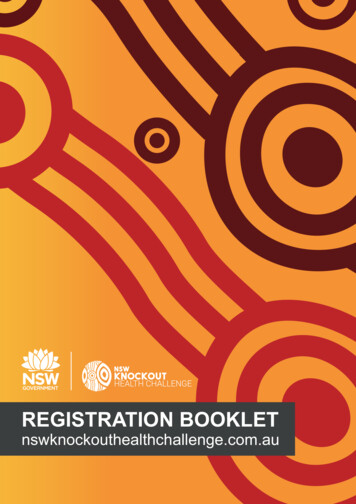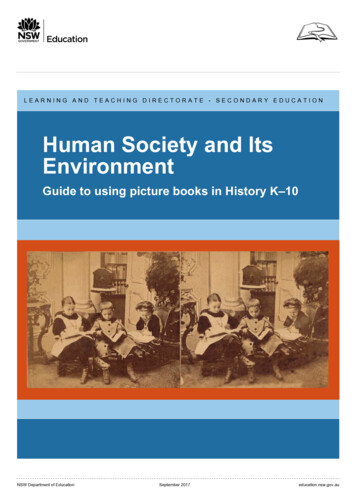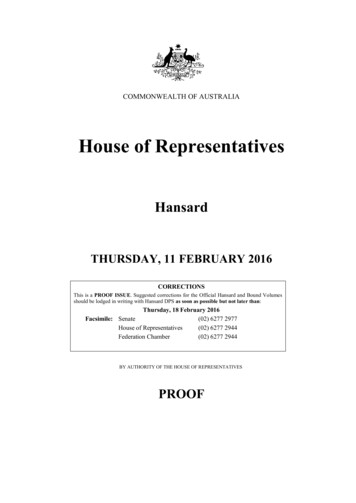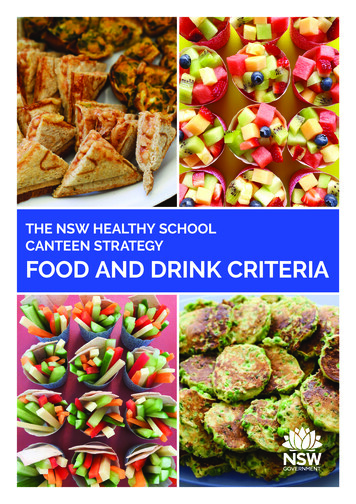
Transcription
THE NSW HEALTHY SCHOOLCANTEEN STRATEGYFOOD AND DRINK CRITERIA
AcknowledgementsThis edition of the Food and Drink Criteria booklet is a rework of earlier editions and includes minor revisions to theoriginal NSW Healthy School Canteen Strategy 2017. A working group, comprised of representatives from the NSWDepartment of Education, NSW Ministry of Health, the Association of Independent Schools of NSW and CatholicSchools NSW were involved in the development of the original Strategy.Thank you to Kathy Low, Canteen Manager of Blairmount Public School and owner of Kathy's Kitchen Facebook pagefor providing some inspiring images used in this document.NSW MINISTRY OF HEALTH20 Christie StreetST LEONARDS NSW 2065Tel: 61 2 9391 9000Fax: 61 2 9391 9101TTY: 61 2 9391 9900www.health.nsw.gov.auThis work is copyright. It may be reproduced in whole or in partfor study or training purposes subject to the inclusion of anacknowledgement of the source. It may not be reproduced forcommercial usage or sale. Reproduction for purposes other thanthose indicated above requires written permission from the NSWMinistry of Health.Copyright NSW Ministry of Health 2020SPHN (OPH) 200264ISBN 978-1-76081-413-7 (print)978-1-76081-414-4 (online)For more information or to download a copy of this document visitthe NSW Healthy School Canteen Strategy sFirst Edition February 2017Second Edition - Reprinted with amendments March 2017Third Edition - Updated with amendments December 2017Fourth Edition – Updated with amendments July 2020
ContentsThe NSW Healthy School Canteen Strategy4The Australian Dietary Guidelines5The Food and Drink Criteria6The six-step guide to a healthy school canteen7Step 1. Remove Sugar-sweetened drinks9Step 2. Classify as Everyday or Occasional10Step 3. Check Health Star Ratings12Step 4. Check portion sizes14Step 5. Balance the menu16Step 6. Market and promote Everyday choices only18Healthy vending machines in schools20Support and more information21Tools:Tool 1. Menu Ready Reckoner23Tool 2. Healthy Food Finder41Tool 3. Fridge and pantry basics42Tool 4. Counting the menu44The NSW Healthy School Canteen Strategy FOOD AND DRINK CRITERIA http://education.nsw.gov.au/healthy-canteens3
The NSW Healthy School Canteen StrategyThe NSW Healthy School Canteen Strategy (the Strategy) supports student health andwellbeing by promoting and increasing the availability of healthy foods and drinks inschool canteens. The Strategy is one component of the NSW Government’s HealthyChildren Initiative that aims to reduce the number of children above a healthy weight.All NSW public schools with a canteenare required to implement the Strategy.Independent and Catholic Schools areencouraged to participate.The Strategy supports a culture of healthy eating inschools by: Promoting and increasing student access tohealthier foods and drinks. Decreasing student access to less healthy foodsand drinks. Supporting water as the drink of choice. Making a healthy choice an easy choice.A healthy school canteen models whatstudents are taught in the classroom abouthealthy eating and supports a whole-schoolcommunity approach to better health.In NSW there are over 2,000 schools that provide acanteen service, making them a frequently accessed foodoutlet for school-aged children. Many students purchaserecess, lunch or both from the canteen and this can makean important contribution to their daily nutrient intake.Healthy eating and regular physical activityhelps children and adolescents maintain ahealthy weight.In 2018, more than 1 in 5 (24%) NSW children aged 5–16years were above a healthy weight - about 270,000children1. Children above a healthy weight are morelikely to carry excess weight into adulthood and are atincreased risk of chronic disease, such as diabetes andheart disease in later life.Healthy eating provides children and adolescents withthe range of nutrients they need for optimal growth anddevelopment and the energy they need for play andphysical activity.The more healthychoices on offer in theschool canteen: the more likely studentsare to choose healthieroptions the more it reinforceshealthy eating messagestaught in the classroom.1. NSW Childhood Overweight and Obesity Detailed Data Report:Available from: -overweight-obesity-detailed-data report.aspx4The NSW Healthy School Canteen Strategy FOOD AND DRINK CRITERIA http://education.nsw.gov.au/healthy-canteens
The Australian Dietary GuidelinesThe Australian Dietary Guidelines provide evidence-based advice for all Australiansabout how to eat a healthy, balanced diet and maintain a healthy weight.The Healthy School Canteen Strategy is based on theAustralian Dietary Guidelines.Key messages from the Australian DietaryGuidelines include: Enjoy a wide variety of nutritious foods from the fivefood groups every day and drink plenty of water.The Australian Guide to Healthy Eating Limit intake of foods containing saturated fat, addedsalt and added sugars.shows a different food group in each of the fivesegments of the circle and the proportions that areneeded for a healthy, balanced diet. Achieve and maintain a healthy weight by beingphysically active and choosing amounts of nutritiousfoods and drinks that meet your energy needs.Visit the Australian Government website Eat forHealth for detailed advice about the amounts andkinds of foods to eat for health and wellbeing:www.eatforhealth.gov.auThese key messages have been incorporated into theAustralian Guide to Healthy Eating (shown below).The Australian Guide to Healthy EatingAustralian Guide to Healthy EatingEnjoy a wide variety of nutritious foodsfrom these five food groups every day.Drink plenty of water.Grain (cereal) foods,mostly wholegrainand/or high cerealfibre varietiesEveryday foods and drinksVegetables andlegumes/beans Eat a wide variety from the five food groupsevery day for good health.Muesli Provide essential nutrients such asprotein, vitamins, minerals and dietary fibre.PolentaQuinoaFettuccinePenneRed kidneybeansWheat flakesRed lentilsChickpeasOccasional foods and drinksRed kidneybeansLentilsMixed nutsChickpeasFruitLean meats andpoultry, fish, eggs,tofu, nuts and seedsand legumes/beans Eat only sometimes and in small amounts.These are mostly foods and drinks high inenergy, saturated fat, sugars and/or salt andoften with little nutritional value. They are not needed as part of a healthy diet.Milk, yoghurt, cheese and/oralternatives, mostly reduced fatUse small amountsSource: National Health and Medical Research Council, 2013Only sometimes and in small amounts Sugar-sweetened drinks and energy drinks shouldnot be sold in school canteens or vending machines.Note The Australian Guide to Healthy Eating is a guide for the general population. Check your school's policy regarding food allergens and refer to your education sector’s anaphylaxis procedures(see page 21 for details). Alcohol is not part of the school environment.The NSW Healthy School Canteen Strategy FOOD AND DRINK CRITERIA http://education.nsw.gov.au/healthy-canteens5
The Food and Drink CriteriaThe Food and Drink Criteria (the Criteria) underpins the Strategy. Use the Criteria whendeveloping your menu and promoting your canteen.The Criteria applies to all foods and drinks sold in theschool canteen. This includes all foods and drinks soldon the regular menu, in specials, meal and snack deals,over the counter and ordered online.The table below shows how the Criteria apply to bothEveryday and Occasional foods and drinks. Each of theCriteria will be explored in more detail in the step-bystep process that follows.The Criteria also applies to vending machines.Food and Drink Criteria for NSW school canteens and vending machinesSugar-sweetened drinks are not for sale in your school canteen orvending machines.Everyday foods and drinksOccasional foods and drinksEveryday foods and drinks makeup at least ¾ (75%) of the menu.Occasional foods and drinks make upno more than ¼ (25%) of the menu.¾3.56¼Portion limits apply to someEveryday foods and drinksincluding flavoured milks, 99%juices and hot foods.Portion limits apply for all Occasionalfoods and drinks.No Health Star Rating requiredon Everyday foods and drinks(except breakfast cereals).A Health Star Rating of 3.5 stars andabove required on all packagedOccasional foods and drinks (exceptdiet drinks).Display, price favourably,promote and advertiseEveryday choices only.Occasional foods and drinks are notpromoted, advertised or displayed inprominent positions.The NSW Healthy School Canteen Strategy FOOD AND DRINK CRITERIA http://education.nsw.gov.au/healthy-canteens
The six-step guide to a healthy school canteenThis section takes you through a six-step process to help you apply the Food and DrinkCriteria to your canteen. Each step is described in detail and at the end of each stepthere is an Action box that summarises what you need to do to complete that step.It is recommended that you work your way through from step 1 to 6 as each step builds onthe previous one.The six steps to a healthy school canteenSTEP 1. Remove Sugar-sweetened drinksSTEP 2. Classify as Everyday or OccasionalSTEP 3. Check Health Star RatingsSTEP 4. Check portion sizesSTEP 5. Balance the menuSTEP 6. M arket and promote Everyday choices onlyThe NSW Healthy School Canteen Strategy FOOD AND DRINK CRITERIA http://education.nsw.gov.au/healthy-canteens7
8The NSW Healthy School Canteen Strategy FOOD AND DRINK CRITERIA http://education.nsw.gov.au/healthy-canteens
Step 1.Remove Sugar-sweetened drinksSugar-sweetened drinks have been banned from sale in NSW public schools (includingin canteens and vending machines) since 2007.Facts about Sugar-sweetened drinksExamples of Sugar-sweetened drinks Sugar-sweetened drinks are non-milk drinks withany type and any amount of sugar added to them. Soft drinks S ugar-sweetened ice blocks and jellies are classifiedas Sugar-sweetened drinks because they aresweetened liquids that have been either frozen or set. Vitamin waters If a drink contains an added source of sugar it is listedin the ingredients list on the product label. Flavoured waters (sparkling or still) Energy drinks Sports drinks Iced teas Fruit drinks (less than 99% juice) Cordial Slushies (with less than 99% juice)Common types of added sugar include:sucrose (usually listed as sugar or cane sugar),glucose, glucose syrup, fructose, honey, fruit juiceconcentrate and deionised fruit juice concentrate. Coconut water (plain or flavoured) Ice-blocks (with less than 99% fruit juice) JellyDiet drinks and no-sugar drinks containing natural andartificial sweeteners (e.g. aspartame and stevia) areclassified as Occasional drinks. Diet energy drinks shouldnot be sold in school canteens.Healthier drinks to sell in the canteenWater is always the healthiest drink. Other popular,healthier options include plain and flavoured milk and 99% fruit/vegetable juice. For more examples, seeTool 1. Menu Ready Reckoner on pages 23-40.Flavoured milk drinks are not classified as Sugarsweetened drinks because they also provide a range ofimportant nutrients such as calcium.Step 1 Actions Look through your menu and circle any Sugar-sweetened drinks that are for sale. This includes sugarsweetened jellies and ice blocks. Remember to include drinks sold over the counter, online and in vending machines.Once you have identified the Sugar-sweetened drinks on your menu, you will be ready to swap them for healthieroptions (See Step 2).The NSW Healthy School Canteen Strategy FOOD AND DRINK CRITERIA http://education.nsw.gov.au/healthy-canteens9
Step 2.Classify as Everyday or OccasionalEVERYDAY FOODS AND DRINKSEveryday meals, snacks and drinks arehealthy foods from the five food groups:Examples of Everyday meals and snacksinclude: grains (e.g. bread, rice, pasta, cereal), mostly wholegrain salads, sandwiches, wraps, burritos, burgers, curries, stirfries with rice or noodles, pasta, lasagne, soup, cereal,yoghurt, fruit salad and vegetable sticks with dips (e.g.hummus and salsa). vegetables fruit milk, yoghurt, cheese, and/or alternatives(e.g. calcium-fortified soy milk), mostly reduced-fat lean meats, poultry, fish, eggs, tofu, nuts andseeds and legumes/beans.Everyday foods and drinks should makeup most of your menu – see Step 5 onpage 16.Ham may be used in Everyday foods and meals such assalads and sandwiches.Examples of Everyday drinks include: water, plain and flavoured milk and 99% fruit/vegetable juice.For a full list of Everyday meals, snacksand drinks refer to Tool 1. Menu ReadyReckoner on pages 23-40.Everyday foods and drinks can be packaged as well as canteen-made Everyday foods and drinks can be made in the canteen, but they can also be packaged, e.g. frozen lasagne, orsnack-packs of fruit. A few foods which are usually Occasional (crumbed foods, garlic bread and pizza) can sometimes be classifiedas Everyday instead, but only if they are healthier versions made in the canteen using healthier ingredients andcooking methods (see page 29 for more information about these foods and how to make them). When preparing Everyday and Occasional foods and drinks in the school canteen, you’ll often need to use somebasic ingredients such as cooking oil, flour, some sauces, stocks, spreads and seasonings. See Tool 3. Fridge andPantry Basics on pages 42-43 for more information about which items to use in your recipes.10The NSW Healthy School Canteen Strategy FOOD AND DRINK CRITERIA http://education.nsw.gov.au/healthy-canteens
OCCASIONAL FOODS AND DRINKSOccasional meals, snacks and drinks aremostly high in energy, saturated fat, sugarsand/or salt and often have little nutritionalvalue.These foods and drinks are not part of the five foodgroups and are not essential for a healthy diet.Occasional foods and drinks can be packaged or freshlyprepared in the canteen.Occasional foods and drinks can be onthe menu each day, but overall, theyshould only make up a small portion ofyour menu - see Step 5 on page 16.What if I add an Occasional food to anEveryday meal, snack or drink?Examples of Occasional foods and drinksinclude: cakes, sweet muffins, sweet biscuits, pies, sausage rolls,processed meats, packaged or commercial pizza, saltysnacks and diet drinks. For a full list of Occasional foodsand drinks see Tool 1. Menu ReadyReckoner on pages 23-40.Do not make or sell any food or drink thatcontains added confectionery.This applies to both canteen-made and packaged foodsand drinks e.g. cakes, slices, sweet pastries, muesli bars,bliss balls, desserts, ice creams and frozen yoghurt.Examples of ways confectionery is added to foods thatmakes them unsuitable for sale in the canteen:Adding an Occasional food or ingredient to an Everydaymeal, snack or drink will change its classification toOccasional. Icing – on cakes, slices, donuts, buns.Examples include adding: bacon to a burger or Caesar salad Filling/ingredient – choc chips in muffins, caramel incaramel slice. salami to a canteen-made pizza Toppings – 100s & 1000s, sprinkles, lollies on cupcakes. Coatings – chocolate coating on ice cream, carob andyoghurt coating on muesli bars. crumbed packaged chicken tender to a wrap or roll pastry to a frittata to make quiche ice-cream to flavoured milk to make a milkshake corn chips to a burrito bowl.Step 2 ActionsU se Tool 1. Menu Ready Reckoner on pages 23-40 to mark all items on your menu as Everyday (E) orOccasional (O). You may also use the online look-up tool Healthy Food Finder to classify packaged food anddrink - see page 41 for more information.Remember to include all items available on the menu, over the counter, online and in specials.Make sure you have removed the Sugar-sweetened drinks you circled in Step 1 and replaced them withEveryday drinks (preferable) or Occasional drinks.The NSW Healthy School Canteen Strategy FOOD AND DRINK CRITERIA http://education.nsw.gov.au/healthy-canteens11
Step 3.Check Health Star RatingsThe Strategy requires Occasional packaged foods and drinks (except diet drinks)and Everyday packaged breakfast cereals to have a Health Star Rating (HSR) of 3.5 starsor above.What is the Health Star Rating?What about canteen-made foods and drinks?The Health Star Rating (HSR) is a quick and easy way tocompare the nutrient content of packaged foods anddrinks within the same category.If you make foods or drinks onsite you do not need tocalculate the HSR. Use Tool 1. Menu Ready Reckoneron pages 23 -40 and Tool 3. Fridge and Pantry Basics onpages 42-43 to help you make these foods and drinks ashealthy as possible.It scores the overall nutritional content of the packagedproduct and rates it from ½ a star to 5 stars. Whencomparing products within the same food category (e.g.chips with chips or pies with pies) the one with the moststars is the healthier choice.The HSR tells you how healthy a product is, but it doesnot tell you how much to serve. For this you need to usethe portion limits listed in Step 4 on pages 14-15.Everyday packaged foods and drinks (except forbreakfast cereals) do not need to have a HSR rating of3.5 stars or above to meet the Strategy. However if youwant to select the healthiest version of an Everydayproduct, choose the one with the highest HSR within thesame category.How can I find the HSR of a product?Why 3.5 stars or above?Most healthy foods anddrinks score 3.5 stars orabove, while most unhealthyones score below 3.5 stars.What about packaged Everyday products?3.5If the HSR is on a packaged product it will be on the frontof the pack. If the HSR is not on the packaging then youcan look up the product in:Healthy Food Finder – see page 41 for details.Healthy Kids Association NSW Buyers' Guide – seepage 23 for details. Note: this Guide does not include allpackaged products that meet the Strategy.For more details about HSR visithttp://healthstarrating.gov.au/12The NSW Healthy School Canteen Strategy FOOD AND DRINK CRITERIA http://education.nsw.gov.au/healthy-canteens
Frequently asked questionsWhat about products bought from a local bakery orlocal butcher?If you are buying products such as pies, sausage rollsand other products from a local bakery, or processedmeat from a local butcher or deli, it is unlikely thatthey will be able to provide you with the HSR of theirproducts.Tips Check the HSR of packaged items on your menufrom time-to-time as they can change. Sometimesmanufacturers reformulate their products, whichcan change the HSR. Check the HSR of all flavours a product comesin as sometimes different flavours have differentHSRs.You can sell these locally purchased products in yourschool canteen without knowing the HSR. However, aimto choose the healthiest type available and make surethey meet the portion size limits.What about special diets and cultural or religiousneeds?School canteens may need to provide food or drinkproducts for students with special diets and culturaland/or religious needs; for example, gluten-free orlactose-free products, or Halal or Kosher foods.In some cases, special diet/religious foods and drinksmay not be available with a HSR of 3.5 stars or above.In these cases aim to provide the healthiest versions ofthese foods and drinks and make sure they meet theportion size limits.Step 3 Actions W ork through your menu – when you come to an Occasional packaged food look up the HSR of that product.Check on the front of the pack, in Healthy Food Finder or in the Buyers Guide (see page 23) .Do the same for the Occasional packaged drinks (note: you don’t need to check diet drinks).Also check that packaged Everyday breakfast cereals have a HSR of 3.5 stars or above.Swap Occasional foods and drinks that have a HSR less than 3.5 stars with similar Occasional products that have aHSR of 3.5 stars or above or swap for Everyday products.The NSW Healthy School Canteen Strategy FOOD AND DRINK CRITERIA http://education.nsw.gov.au/healthy-canteens13
Step 4.Check portion sizesStudents need appropriate-sized portions to meet their energy and nutritional needs.The Strategy specifies maximum portion size limits for all Occasional foods and drinksand some Everyday foods and drinks, including Everyday hot foods, some Everydaydrinks and Everyday frozen ice snacks.The tables below and opposite offer a quick guide to portion sizes for Everyday and Occasional foods and drinks. Some ofthe foods and drinks listed below have additional requirements that need to be met in order to be sold in school canteens,such as HSR requirements and/or preparation requirements.Tips If batch cooking in your canteen, weigh out a single serve that meetsthe portion limit, take a photo and display in the canteen for staff andvolunteers to follow. In Central or K-10/12 schools, both portion sizes may be provided, with thelargest size available only to secondary students. The portion size of hot meals refers to the product ‘as sold in the canteen’.For example, a burger meal for sale in a primary school must weigh nomore than 250g – that includes the burger patty, the bun and the saladitems on the bun.It is important to check Tool 1. Menu Ready Reckoner on pages 23-40 which lists allrequirements as well as additional examples from each food and drink category.Everyday food or drinkMaximum portion sizePrimary schoolSecondary schoolHot Everyday foode.g. pasta dishes, stir fries, curries, burgers, burritos, dim sum250g350gCrumbed foods (freshly prepared) e.g. crumbed chicken baked inschool canteen (may be served alone or in a food/meal)140g140gPizza (canteen-made) with Everyday toppings 250g350g75g75g 99% fruit and/or vegetable juicesincludes those made into jelly or ice blocks or blended with ice250ml250mlFlavoured milk, hot chocolate, milkshakes/smoothies(without ice cream/gelato/sorbet/frozen yoghurt), breakfastdrinks, drinking yoghurt300ml500mlGarlic bread (canteen-made) See Tool 1. Menu Ready Reckoner on page 29 for preparation instructions.14The NSW Healthy School Canteen Strategy FOOD AND DRINK CRITERIA http://education.nsw.gov.au/healthy-canteens
Occasional food or drinkMaximum portion sizePrimary schoolSecondary schoolProcessed meats e.g. bacon, devon, salami, sausages60g60gCrumbed/coated foods (packaged)140g140gCorn chips/hard taco shells/bowls30g30gPizza (packaged or with Occasional toppings)250g350gHot meals with Occasional foods or fillingse.g. sausage sandwich, pasta carbonara with bacon250g350gHot potato products e.g. hot chips, wedges, hash browns100g100gPies e.g. meat pie, vegetable pie180g180gPotato-topped pies250g250gSavoury pastries e.g. sausage rolls, quiche, spring rolls120g120gSavoury rolls with processed meats e.g cheese and bacon roll75g75gGarlic bread (packaged)75g75g75g (dry weight)75g (dry weight)30g30g60g (dip & crackers)60g (dip & crackers)Cakes, sweet pastries, muffins, waffles, banana bread80g80gSweet biscuits, muesli/snack/protein bars and balls50g50gDesserts e.g. mousse, puddings, coconut-milk-based yoghurt100g100gDiet l300ml500mlIce cream, frozen yoghurt, gelato125ml125mlIce blocks and frozen drinks with added sweeteners250ml500mlOccasional foods and fillingsHot foodsInstant flavoured noodlesSnack itemsSalty snacks e.g. chips, flavoured savoury biscuits/rice snacksDips (Cheese spread and cream cheese/sour cream-based dips)DrinksDiet and no-sugar drinks (with sweeteners)Coffee/iced coffee made with real coffee (secondary only)Milkshakes & smoothies with ice cream/gelato/sorbet/frozen yoghurtFrozen ice snacks*Most confectionery should not be sold in school canteens. Check the Menu Ready Reckoner on page 35 for more information.Step 4 ActionsGo through your menu and check that portion sizes do not exceed the maximum for:O ccasional foods and drinks.E veryday hot meals including canteen-made garlic bread.E veryday drinks including frozen ice snacks.S wap any packaged items that exceed portion limits with items that meet portion limits.R educe the portion size of any canteen-made items that exceed portion limits.The NSW Healthy School Canteen Strategy FOOD AND DRINK CRITERIA http://education.nsw.gov.au/healthy-canteens15
Step 5.Balance the menuA healthy school canteen menu needs to comprise at least ¾ (75%) Everyday foods anddrinks and no more than ¼ (25%) Occasional foods and drinks.The way you structure your menu can encouragestudents to eat a variety of nutritious foods.Providing Everyday options in each section of the menugives students healthy choices within cold foods, hotfoods, snacks and drinks.Occasional foods and drinks can appearon your menu each day, however theycannot make up more than ¼ (25%) ofthe menu.Include in the count: Only items offered at recess and/or lunch.Balancing the menu means counting all the Everydayand Occasional foods and drinks available for sale inyour school canteen, including on the menu, on thecounter top and ordered online. A quick guide on howto count your menu is provided opposite with moredetailed information provided in Tool 4. Counting Toolon pages 44-45. All flavours and portion sizes available. Count each day separately if you have different items ondifferent days of the week.Do not include in the count: Sauces and condiments. 'Toasted’ option for sandwiches/wraps. Repeated items: for example garlic bread offered as asnack and in a meal deal is only counted once.Step 5 ActionsUse the counting rules to work out the proportion of Everyday and Occasional items on yourmenu. An example of how to count a menu and calculate the proportion of Everyday foodand drinks is shown on the page opposite. More detailed instructions are provided in Tool 4.Counting Tool on page 44.If the proportion of Everyday items is less than ¾ (75%):S wap some Occasional items for similar Everyday items.R emove less popular Occasional foods and drinks.R educe the number of flavours/varieties of Occasional snacks such as chips and frozen snacks.I ncrease the number of flavours/varieties of Everyday items.Do not forget to re-check your count after you have made these changes.16The NSW Healthy School Canteen Strategy FOOD AND DRINK CRITERIA http://education.nsw.gov.au/healthy-canteens
Example menu countSCH00L CANTEEN MENUEveryday itemsOccasional itemsSandwiches RollsHot FoodsVegemite1Meat Pie1Strawberry Jam1Spinach Ricotta roll1Cheese1Party Pie11Pizza (pepperoni)11Fried Rice11Crumbed Tender11Lasagne1Corn Cob1EggHam, Cheese & TomatoTuna SaladCount extrasexcept for sauces/condiments Flame Grilled Chicken Burger(with mayo, lettuce, cheese & tomato)Salad onlyExtras Cheese1Avocado, Mayo2Make it toasted .50cDon’t counttoasted versionsif fillings are thesame as freshSaladsSauce Tomato/BBQRecess Snack Pack1 alad Cold MeatS(Ham/Tuna/Chicken)3 Salad Grilled Chicken1 Salad Chicken Tender (crumbed)1 Apple PiecesParty PiesCrumbed Tender00Repeateditems notcounted0Corn CobWraps Sweet Chilli Chicken Wrap(flame grilled chicken, lettuce, tomato, cheese)1 rumbed Tender WrapC(Crumbed chicken tender, carrot, lettuce,avocado spread)10Drinks Water1 Milk (Chocolate or Strawberry)2 Juice box (200ml) (Apple, Tropical, or ABC)3 Popper (200ml) (Apple, Tropical or ABC)3 Sparkling Juice (250ml) (Raspberry, Grape)2 Slushy (99% Apple Juice)1 Hot/Cold MiloBeetroot, Tomato, MayoSnacks1(Carrot sticks, plain crackers, hummus) aladS(lettuce, tomato, cheese, beetroot, carrot)Extras Pineapple,0Don’t countcondiments1Count all sizesand flavours ofdrinks1Ice Blocks Ice CreamsCount of 1 for allsalad extras Ice Snack (Chocolate, Lemon)21 Juice Sticks (Tropical)1 Vanilla Yoghurt with Fruit1Light Vanilla Ice Cream cup1 Yoghurt with Granola1 Seasonal Fruits (Orange, Banana)2 Chips Sea Salt1 Freshly Popped Plain Popcorn1 Popcorn Sweet n Salty1 99% Fruit Juice Jelly cups1Pikelet Toppings1 Apple Pieces Frozen Yoghurt2(Vanilla/choc or vanilla/strawberry)Do the mathsTotal number of Everyday choices Total number of Occasional choices Total number of menu choices % of Everyday choices (45/57) x 100 % of Occasional choices (12/57) x 100 Result:45125779%21%AchievedThe NSW Healthy School Canteen Strategy FOOD AND DRINK CRITERIA http://education.nsw.gov.au/healthy-canteens17
Step 6.Market and promote Everydaychoices onlyMarketing and promoting the Everyday foods and drinks on your menu will help to makethem stand out and sell well. You can attract students to your healthier Everyday foodsand drinks by using the four ‘Ps’ of marketing:ProductEnsure at least ¾ (75%) of the menu is filled with a rangeof Everyday foods and drinks. Everyday items on themenu that look appealing and taste great will encouragestudents to try new foods and keep them coming back.Posters and other promotional materials can bedownloaded from the Healthy Canteen sPricePrice the Everyday items well to make them great valuefor-money. Only include Everyday foods and drinks inmeal deals or specials offers.PlacePut only Everyday foods and drinks in prominent positionssuch as at the front of displays and counter tops and inthe middle shelves in fridges.Note: Only put Everyday foods and drinks at thepoint of sale – next to cash registers or where moneyis exchanged. For self-serve canteens, check thatOccasional foods or drinks are not within arm's length ofthe register.PromotionPromote only Everyday foods and drinks on menu boards,signage, posters, school newsletters and websites.18The NSW Healthy School Canteen Strategy FOOD AND DRINK CRITERIA http://education.nsw.gov.au/healthy-canteens
What is a 'special' or a 'meal/snackdeal'?The Strategy defines a special as any item on themenu or on a specials board that is:Only Everyday foods and drinks can beoffered as specials and included in mealor snack deals. promoted, highlighted or called a special, or advertise
healthier options include plain and flavoured milk and 99% fruit/vegetable juice. For more examples, see Tool 1. Menu Ready Reckoner on pages 23-40. Flavoured milk drinks are not classified as Sugar-sweetened drinks because they also provide a range of important nutrients such as calcium. Examples of Sugar-sweetened drinks nk sSt i odf r
